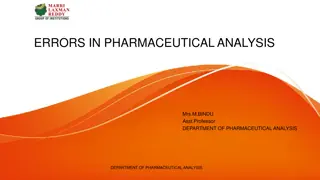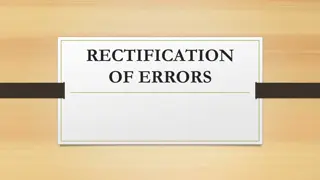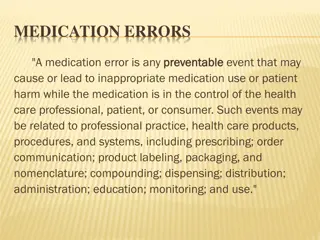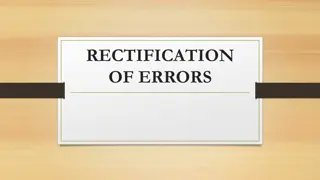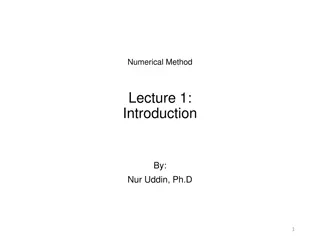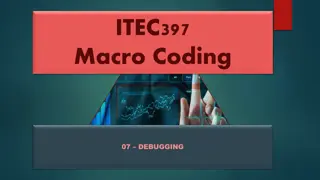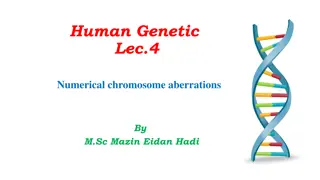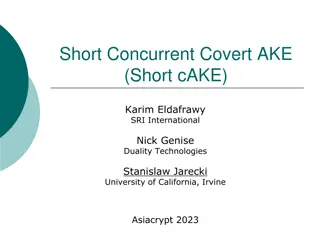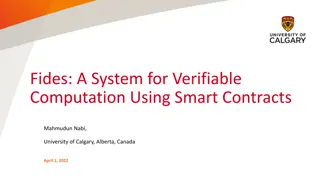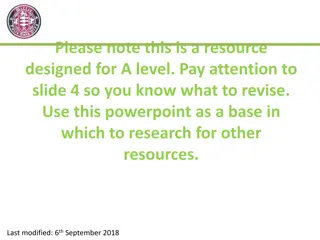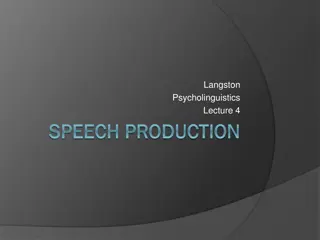Understanding Numerical Methods and Errors in Computation
Delve into the world of numerical methods through the guidance of Dr. M. Mohamed Surputheen. Explore topics such as solving algebraic and transcendental equations, simultaneous linear algebraic equations, interpolation, numerical integration, and solving ordinary differential equations. Learn about errors in computation, including round-off errors and truncation errors, as well as measuring errors using absolute, relative, and percentage error methods.
Download Presentation

Please find below an Image/Link to download the presentation.
The content on the website is provided AS IS for your information and personal use only. It may not be sold, licensed, or shared on other websites without obtaining consent from the author. Download presentation by click this link. If you encounter any issues during the download, it is possible that the publisher has removed the file from their server.
E N D
Presentation Transcript
NUMERICAL METHODS By Dr. M. Mohamed Surputheen
Overview Errors Solution of algebraic and transcendental equations Solution of Simultaneous linear algebraic equations Interpolation Numerical Integration Numerical Solution of ordinary Differential Equations
ERRORS IN COMPUTATION Defined as the difference between the true value in a calculation and the approximate value found using a numerical method etc. Error (e) = True value Approximate value. Numerical methods yield approximate results that are close to the exact analytical solution.
Types of Errors Round off error: Errors due to finite representation of numbers are called Round off Errors. Numbers such as , e, or 7 cannot be expressed by a fixed number of significant figures. Therefore, they can not be represented exactly by a computer which has a fixed word-length. = 3.1415926535 . Difference introduced by this omission of significant figures is called round-off errors. Rounding a number can be done in two ways. One is known as chopping and other is known as rounding. If is to be stored on a base-10 system carrying 7 significant digits, chopping : =3.141592error: t=0.00000065 round-off: =3.141593error: t=0.00000035 Some machines use chopping, because rounding has additional computational overhead.
Truncation Error: Errors due to finite representation of an inherently infinite process is called truncation errors. For example, the use of finite number of terms in the infinite series expansion of Sinx = x - x3/3! + x5/5! x7/7! +... Cosx = 1-x+x2/2!-x4/4!+ . ex= 1 + x + x2/2! + x3/3! + When we calculate these series, we cannot use all the term in series for computation. We usually terminate the process after a certain term is calculated. The terms truncated introduce an error which is called truncation error.
MEASURE OF ERRORS Three ways of measuring the error are: 1. Absolute error 2. Relative error 3. Percentage error If X is the true value of a quantity and X' is its approximate value, then Absolute error: Absolute error is defined as ea= |True value Approximate value| Error X X = = ae
MEASURE OF ERRORS Relative error: Relative error is defined as: Error X X = e = r True Value X Percentage error: Percentage error is defined as: X X = = 100 100 e e p r X
Examples Suppose 1.414 is used as an approximation to . Find the absolute, relative and percentage errors. 41421356 . 1 2 = = = ae Error er= 00021356 . 0 = re = r p e e 2 ae ( ) absolute error True value Approximat value e 00021356 . 0 = 1.41421356 - 1.414 ( ) relative error True Value . 0 = 151 10 3 2 ( ) percentage error 100 . 0 = 151 10 % 1
Examples Example 2: If = 22/7 is approximated as 3.14, then find the absolute, relative and percentage errors. 22 7 0.0028571 22/7 Ep ErX = 22 21.98 7 0.02 7 = = = = absolute error 3.14 0.0028571 Ea = = Re error 0.000909 lative Er 100 0.0909% = error Percentage
Solution of Algebraic and Transcendental Equations Algebraic Equation: If f(x) is a polynomial in x, then f(x) = 0 is an algebraic equation. Examples: x3+ 4x2 1 = 0 , x4+ 5x3 6x2+ 3x + 5 = 0, x2 3x + 1 = 0 Transcendental Equation: If f(x) contains algebraic and non algebraic functions namely exponential, logarithmic and trigonometric functions then f(x) = 0 is called transcendental equation. Examples: x + log x + sin x=0, xsinx+cosx=0, Xex-1 = 0
Direct and Iterative Methods Direct Methods: These methods give the exact values of all the roots in a finite number of steps. Direct methods require no knowledge of the initial approximation of a root of the equation f(x) = 0 Examples: solving quadratic equation, Synthetic division etc Note: By using Directive Methods, it is possible to find exact solutions of the given equation. Iterative Methods (Indirect Methods): These methods are based on the idea of successive approximations. We start with one or two initial approximations to the root and obtain a sequence of approximations. Iterative methods require knowledge of the initial approximation of a root of the equation f(x) = 0 Examples: Bisection, False position, Newton-Raphson methods Note: By using Iterative methods, it is possible to find approximate solution of the given equation .
Need for iterative Methods The value of x which satisfying the equation f ( x) = 0 is called the root of the equation. If f(x) is a quadratic, cubic or a biquadratic expression, then algebraic formulae are available to obtain the roots . If f(x) is a polynomial of higher degree or an expression involving transcendental functions then algebraic methods are not available. So these types of equation can be solved by iterative methods such as Bisection Method False position Method Newton-Raphson Method Iteration Method
Two Fundamental Approaches BRACKETING METHOD The bracketing methods require the limits between which the root lies. Examples: Bisection and False Position Methods OPEN METHOD The open methods require the initial estimate of the solution. Examples: Newton Raphson And Method of successive approximation methods
Procedure for Bisection Method 1. Find an interval [x0,x1] so that f(x0)f(x1) < 0 2. Find x2= (x0+x1)/2. 3. If f(x2) = 0, then x2is the root of the equation. 4. If f(x2) 0 and f(x0)f(x2) < 0, root lies in [x0,x2]. 5. Otherwise root lies in [x2,x1]. (ie) If f(x2) 0 and f(x0)f(x2) > 0 then x0=x2else x1=x2 6. We continue this process until we find the root (i.e., x2= 0), or the latest interval is smaller than some specified tolerance.
Examples: 1) Find a real root of the equation x3-2x-5=0 using Bisection method Let f(x)= x3-2x-5=0 f(2)=-1 and f(3)=16 i.e. A root lies between 2 and 3. Condition for the next iteration If sign(f0) = sign(f2) then x0=x2; else x1=x2; _____________________________________________________________ Iteration x0 x1 x2 f0 f1 f2 _____________________________________________________________ 1 2.000 3.000 2.500 -1.000 16.000 5.625 2 2.000 2.500 2.250 -1.000 5.625 1.891 3 2.000 2.250 2.125 -1.000 1.891 0.346 4 2.000 2.125 2.062 -1.000 0.346 -0.351 5 2.062 2.125 2.094 -0.351 0.346 -0.009 _____________________________________________________________ App.root = 2.094
2) Find one root of ex 3x = 0 correct to two decimal places using the method of Bisection. f (x) = ex 3x f (1) = e1 3(1) = 0.283 f (2) = e2 3(2) = 1.389 a root lies between 1 and 2 Condition for the next iteration If sign(f0) = sign(f2) then x0=x2; else x1=x2; _________________________________________________________________ Iteration x0 x1 x2 f0 f1 f2 __________________________________________________________________ 1 1.000 2.000 1.500 -0.282 1.389 -0.018 2 1.500 2.000 1.750 -0.018 1.389 0.505 3 1.500 1.750 1.625 -0.018 0.505 0.203 4 1.500 1.625 1.562 -0.018 0.203 0.083 5 1.500 1.562 1.531 -0.018 0.083 0.030 6 1.500 1.531 1.516 -0.018 0.030 0.005 _________________________________________________________________ App.root = 1.516
3. Find the two roots of the equation xsinx+cosx=0 using Bisection method f(x)= xsinx+cosx=0 f(2)= 2sin2+cos2 = 1.402 f(3)= 3sin3+cos3 = -0.567 a root lies between 2 and 3. Condition for the next iteration If sign(f0) = sign(f2) then x0=x2; else x1=x2; __________________________________________________________________ Iteration x0 x1 x2 f0 f1 f2 ___________________________________________________________________ 1 2.000 3.000 2.500 1.402 -0.567 0.695 2 2.500 3.000 2.750 0.695 -0.567 0.125 3 2.750 3.000 2.875 0.125 -0.567 -0.207 4 2.750 2.875 2.812 0.125 -0.207 -0.037 5 2.750 2.812 2.781 0.125 -0.037 0.045 6 2.781 2.812 2.797 0.045 -0.037 0.004 ___________________________________________________________________ App.root = 2.797
f(x)= xsinx+cosx=0 f(-2)= -2sin(-2)+cos(-2) = 1.402 f(-3)= -3sin(-3)+cos(-3) = -0.567 Another root lies between -2 and -3. __________________________________________________________________ iteration x0 x1 x2 f0 f1 f2 ___________________________________________________________________ 1 -2.000 -3.000 -2.500 1.402 -0.567 0.695 2 -2.500 -3.000 -2.750 0.695 -0.567 0.125 3 -2.750 -3.000 -2.875 0.125 -0.567 -0.207 4 -2.750 -2.875 -2.812 0.125 -0.207 -0.037 5 -2.750 -2.812 -2.781 0.125 -0.037 0.045 6 -2.781 -2.812 -2.797 0.045 -0.037 0.004 ____________________________________________________________________ App.root = -2.797
Bisection Method Advantages: Disadvantages: Simple and easy to implement We need two initial guesses a and b which bracket the root. One function evaluation per iteration Slowest method to converge to the solution. No knowledge of the derivative is needed When an interval contains more than one root, the bisection method can find only one of them.
Procedure for False Position Method 1. Locate the interval [x0, x1] in which root lies. 2. First Approximation to the root using 3. If f(x2) = 0, x2 is the root. 4. 4. If f(x2) 0 and f(x0)f(x2) > 0 then x0 =x2 else x1=x2 5. Repeat the process until the root converges. ( ) ( x ( ) x f x x f x 0 1 1 0 x = 2 ) ( ) f f x 1 0
False Position Method Advantages: 1. Simple 2. Brackets the Root Disadvantages: 1. Can be slow 2. Like Bisection, need an initial interval around the root.
Example1: Compute the roots of the equation x3-4x-9=0 by Regula Falsi method. Given f(x)= x3-4x-9=0 f(2)= 23-4x2-9= -9 f(3)= 33-4x3-9= 6 _________________________________________________________________ x0 x1 x2 f0 f1 f2 _________________________________________________________________ 2.000000 3.000000 2.600000 -9.000000 6.000000 -1.824002 2.600000 3.000000 2.693252 -1.824002 6.000000 -0.237225 2.693252 3.000000 2.704918 -0.237225 6.000000 -0.028912 2.704918 3.000000 2.706333 -0.028912 6.000000 -0.003497 _________________________________________________________________ App.root = 2.706333
Example2: using regula falsi method find a real root of the equation xlog10x-1.2=0 correct up to 3 places of decimals f(x)= xlog10x-1.2 f(1)= 1log101-1.2 =-1.2 f(2)= 2log102-1.2= -0.597940 f(3)= 3log103-1.2=0.231364 _______________________________________________________________ x0 x1 x2 f0 _______________________________________________________________ 2.000000 3.000000 2.721014 -0.597940 0.231364 -0.017091 2.721014 3.000000 2.740206 -0.017091 ________________________________________________________________ f1 f2 0.231364 - 0.000384 App.root = 2.740206
False Position Method Advantages: 1. Simple 2. Brackets the Root Disadvantages: 1. Can be slow 2. Like Bisection, need an initial interval around the root.
Procedure for Newton-Raphson Method 1. Locate the initial value x0. 2. Evaluate 3. Use an initial guess of the root, x0, to estimate the new value of the root, x1, as ( ) ( ) x f ( ) x f x f x x 0 = 0 1 0 4. If f(x1) = 0, x1 is the root. 5. If f(x1) 0 then x0 =x1 6. Repeat the process until the root converges.
Newton-Raphson method - Examples Example1: Find a real root of the equation f(x)=x3 -2x-5=0 using Newton raphson method. Given f(2)=23 -2x2-5= -1 f(3)=33 -2x3-5= 16 choose x0 = 2 f (x) = 3x2-2 ________________________________________________________ x0 f(x0) f'(x0) x1 f(x1) _______________________________________________________ 2.000000 -1.000 10.000000 2.100000 0.060999 2.100000 0.060999 11.229999 2.094568 0.000185 _______________________________________________________ App.root = 2.094568
Find the root of the equation f(x)=3x-cosx-1=0 F (x)= 3+sinx The root lies between 0 and 1 ______________________________________________ x0 f(x0) ______________________________________________ f'(x0) x1 f(x1) 0.000000 -2.000 3.000000 0.666667 0.214113 0.666667 0.214113 3.618370 0.607493 0.001397 _____________________________________________ App.root = 0.607493
Evaluate l2 to three decimal places using Newton-Raphson method. X= l2 or x= 12 or x2-12 f(x)=x2-12 =0 f(3) =-3 and f(4)=4 f (x) =2x a root lies between 3 and 4. Choose x0=4 ____________________________________________ x0 ______________________________________________ 4.000000 4.0000 8.000000 3.500000 0.25000 3.500000 0.25000 7.000000 3.464286 0.001276 ____________________________________________ The approximate root is 3.464286 f(x0) f'(x0) x1 f(x1)
Find a real root of the equation f(x)=xex -1 =0 F (x)= (1+x)ex Root lies between 0 and 1. Choose x0 =1 _______________________________________________________________ x0 _______________________________________________________________ 1.000000 1.71828 2 5.436563 0.683940 0.355342 3.337012 0.577454 0.028734 2.810231 ____________________________________________________________ f(x0) f'(x0) x1 f(x1) 0.683940 0.577454 0.567230 0.355342 0.028734 0.000239 App.root = 0.567230
Newton-Raphson Method Advantages: 1. Converges fast, if it converges and requires only one guess 2. The method is quadratically convergent, that is the number of decimal places of accuracy nearly doubles at each iteration 3. Starting point can be arbitrary Disadvantages: The Newton-Raphson method requires the calculation of the derivative of a function, which is not always easy. If f' vanishes at an iteration point, then the method will fail to converge.
Method of successive approximation or Fixed Point Iteration method Consider the equation f(x) = 0 Rewrite the equation f(x) = 0 in the form x = g(x). If the initial approximation is x0 , then calculate x1 = g(x0) x2 = g(x1) x3 = g(x2) x4 = g(x3) and so on .. Xi+1 = g(xi) Theorm If g(x) and g'(x) are continuous on an interval containing a root of the equation g(x) = x, and if |g'(x)| < 1 for all x in the interval then the series xn+1 = g(xn) will converge to the root.
Iteration Method: Convergence Conditions 1. Convergence of xn+1 = g(xn), when | g (x) | < 1 2. xn+1 = g(xn) oscillates but ultimately converges, when | g (x) | < 1, but g (x) < 0 3. xn+1 = g(xn) diverges, when g (x) > 1
Procedure for fixed point Iteration 1. Re-write f (x) = 0 as x = g(x) 2. Start with an initial guess x0 3. find g (x1) , if g (x1) < 1. 4. Compute x1, x2, x3, . . . Using xi+1 = g(xi ) 5. Repeat step 4 several times until convergence is achieved.
Iteration Method: Example2 Find a real root of the equation f(x)= x3+x2-1 = 0 using iteration method. f(0) = -1 and f(1) =1. A root lies between 0 and 1, Rewrite g(x) x3 + x2 - 1=0 or, x3 + x2 = 1 or, x2(x+1) = 1 or, x2 = 1/(x+1) or, x = 1/ (x+1) x = g(x)=1/ (x+1) g(x)=1/ (x+1) Let, x0 =1 The required root is 0.7548 x0 = 1.00000 x1 = 0.70711 x2 =0. 76537 x3 = 0.75263 x4 = 0.75536 x5 = 0.75477 x6 = 0.75487 x7 = 0.75487 1 1) + = '( ) g x 3/2 2( x 1 1 1) + = '( ) g x 3/2 for all x in (0,1) 2( x
Example 3:Find the root of the equation 2x = cosx + 3 correct to three decimal places. The given can be written as f(x)=cosx+3-2x f(0)=4,f(1)= 1.5403,f(2)=-1.4161,Let x0=1 1(cos 3) 2 1 ( ) (cos 3) 2 1 sin '( ) 2 x0 = 1.0000 x1 = 1.7702 x2 = 1.4010 x3 = 1.5845 x4 = 1.4931 x5 = 1.5388 x6 = 1.5160 x7 = 1.5274 x8 = 1.5217 x9 = 1.5245 x10 = 1.5231 = + x x = + g x x x = g x Hence the iteration method can be applied to the given equation.. The Root is 1.5231
Iterative Method: Drawbacks We need an approximate initial guesses x0. It is also a slower method to find the root. If the equation has more than one roots, then this method can find only one of them.
Solution of linear algebraic equations A system of m linear equations (or a set of n simultaneous linear equations) in n unknowns x1,x2,x3 xn is a set of equations of the form, + + + + + + = = 11 1 a x a x a x a x a x a x a a + 12 2 1 1 1 n n n + 21 1 22 2 2 2 1 n n n + + + = 1 1 n a x a x a x a + 2 2 1 n nn n nn The system can be written in a matrix format as Ax = b, when a a a a a a x x a a + 11 11 1 1 1 1 n n + 21 22 22 2 2 1 n = = = A x b a a a x a + 1 2 1 n n nn n nn
Two approaches for solving systems of linear equations 1.Direct Methods direct methods solve a system of linear equations in a finite number of steps. The solution do not contain any truncation errors. These direct techniques are useful when the number of equations involved is not too large . Examples of direct methods: Gauss Elimination and Gauss-Jordan Elimination. 2.Iterative Methods These methods require an initial approximation of the solution. Then the successive approximations are obtained till they reach some accepted level of accuracy. The solution contains truncation error. These iterative methods are more appropriate when the number of equations involved is large or when the matrix is sparse. Examples of iterative methods: Jacobi method and Gauss Seidel iterative methods 38
Gauss Elimination method Gauss elimination is the most important algorithm to solve systems of linear equations. In gauss elimination method, the given system of linear equations is converted to upper triangular system by elimination of variables. The upper triangular system is then solved by backward substitution. Consider the following three simultaneous equations in 3 unknowns 11 1 a x +a x +a x =a a x +a x +a x =a a x +a x +a x =a 12 2 13 3 14 21 1 22 2 23 3 24 31 1 32 2 33 3 34 a a a a a a a a a x x x a 11 12 13 1 14 = a 21 22 23 2 24 a 31 32 33 3 34
1. Write the augmented matrix for the system of linear equations. 2. Forward elimination of unknowns. Use elementary row operations on the augmented matrix to transform the matrix into upper triangular form. If a zero is located on the diagonal, switch the rows until a nonzero is in that place. 3.Use back substitution to find the solution of the problem.
1. Write the augmented matrix for the system of linear equations An augmented matrix is a matrix containing the coefficients and constants from a system of equations. The augmented Matrix of the above system is a a a a a a a a a a 11 12 13 14 a a 21 22 23 24 31 32 33 34 2.Triangularization or Forward elimination of unknowns. a Step 1. R = R -R *a 21 2 2 1 11 a Step2. R = R -R *a 31 3 3 1 11 a Step 3. R = R -R *a 32 3 3 2 22
3.Back substitution. Back-substitution is the process of solving a system by beginning with the last equation, sequentially moving up through all the equations, and using each equation to solve for one variable at a time. Starting with the last row, solve for the unknown, then substitute that value into the next highest row. Because of the upper-triangular nature of the matrix, each row will contain only one more unknown. " " 33 ' 23 3 -a x )/a x =a x =(a x =(a -a x -a x )/a /a 3 34 ' 24 ' 22 2 1 14 12 2 13 3 11
Examples Apply Gauss elimination method to solve the equations 2 4 4 2 5 1 2 x x + + + + + = 3 1 = = x x x x 1 2 x 3 + 7 9 1 3 x x 1 2 3 3 Solution The augmented Matrix of the above system is 2 5 9 3 Eliminate x from second and third equations 4 R = R -R *2 R = R -R * 2 1 3 1 4 4 7 1 1 2 ,R = R -R *2 2,R = R -R *1 2 2 1 3 3 1 2 2 1 3 3 1
The above matrix becomes 0 4 6 2 2 1 3 0 2 1 -1 1 R =R -R * R = R -R *1 2 2 2 1 3 3 1 Eliminating X2 from Equation 2 0 0 -4 - 4 2 1 0 2 3 1 -1 1 4 2 R =R -R * 3 3 2
Back substitution Fromthe3rdrow,-4x = -4 3 x = 1 3 Fromthe2ndrow,2x = -2 2 x = -1 2 Fromthe1strow,2x + x + 3x = 1 1 2 3 2x -1+ 3 = 1 2x = 1- 2 = -1 1 1 1 x = -2 1 1 2 x1=- x2=-1 x3=1
Solve the following system of equations by Gauss elimination method 3x+2y +3z =18 x +4y +9z =16 2x+y +z =10 The augmented Matrix is 3 2 3 18 1 4 9 16 2 1 1 10 Eliminate x from the second and third equations 0 -1 - 2 3 3 2 3 18 1 3 10 3 -1 R = R -R * 0 8 10 2 2 1 2 3 R = R -R * 3 3 1
Eliminate y from the third equation 3 2 3 18 10 3 0 8 10 -1 5 1 0 0 -1 R = R +R 3 3 2 10 By back substitution z = 5 y = -9 x = 7
Pitfalls in Gauss elimination 1.Pivoting 2. Ill-cnditioned equations. 1.Pivoting: In each step of the elimination procedure, the diagonal element aii is called pivot element. If a pivot element is zero or close to zero, elimination step leads to division by zero. In such situation, we rewrite the equations in different order to avoid zero pivot. Changing the order of equations to avoid zero element on the diagonal is called pivoting. If aii = 0, we interchange the ith row (called the pivot row) with any other row below it, preferably with the row having numerically greatest element in the ith column. This process of interchange of rows of the coefficient matrix is called pivoting.
Example using pivoting Solve by gauss elimination method x +x +x = 6 3x +3x +4x = 20 2x +x +3x =13 1 2 3 1 2 3 1 2 3 1 1 3 3 2 1 1 4 3 13 6 The augmented matrix is 20 Eliminate x from second and third equations 1 1 0 0 -1 1 1 0 1 2 1 6 R =R -R * 3 2 2 1 R = R -R *2 1 3 3 1
Now the row can not be used as a pivot row, ass a22=0, interchange second and third rows, we obtain 0 0 1 x =2 x =1 x =3 1 0 -1 1 1 1 6 1 2 3 2 1




